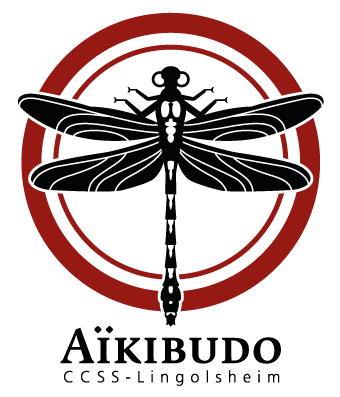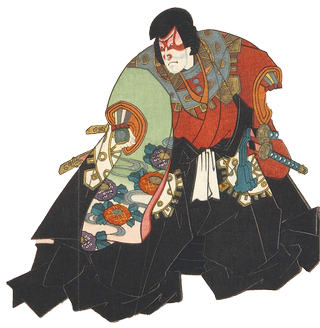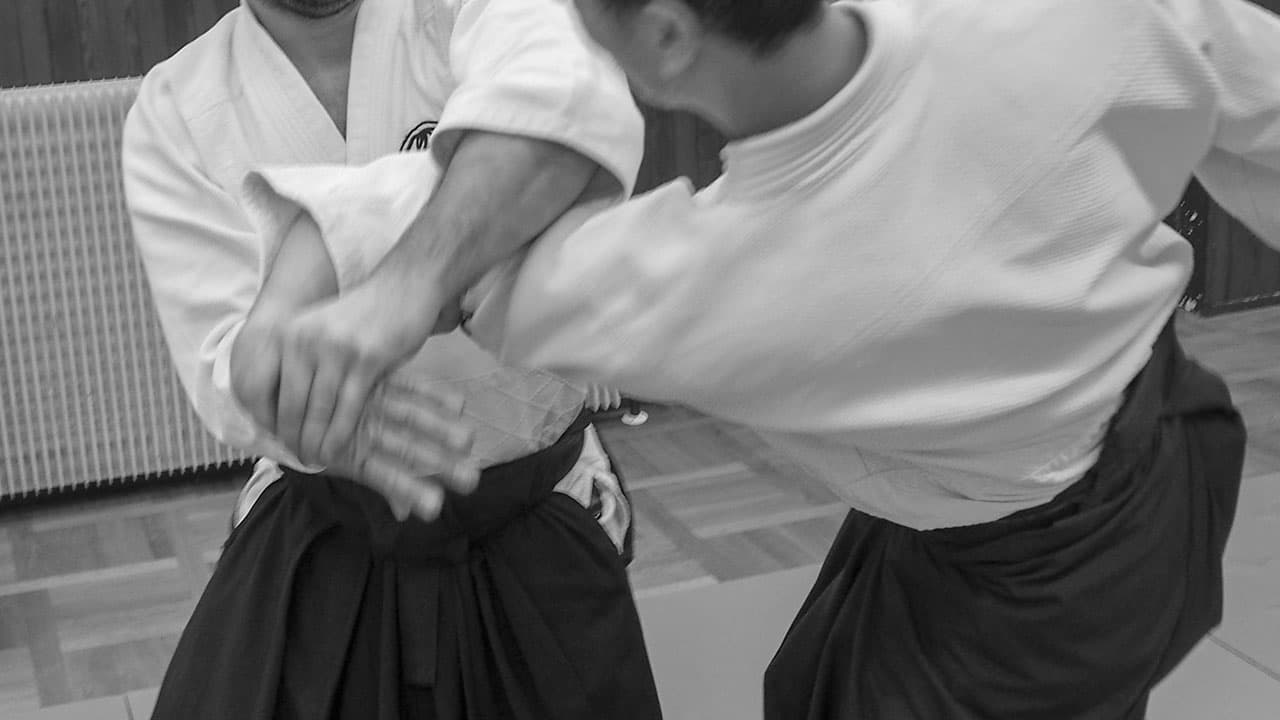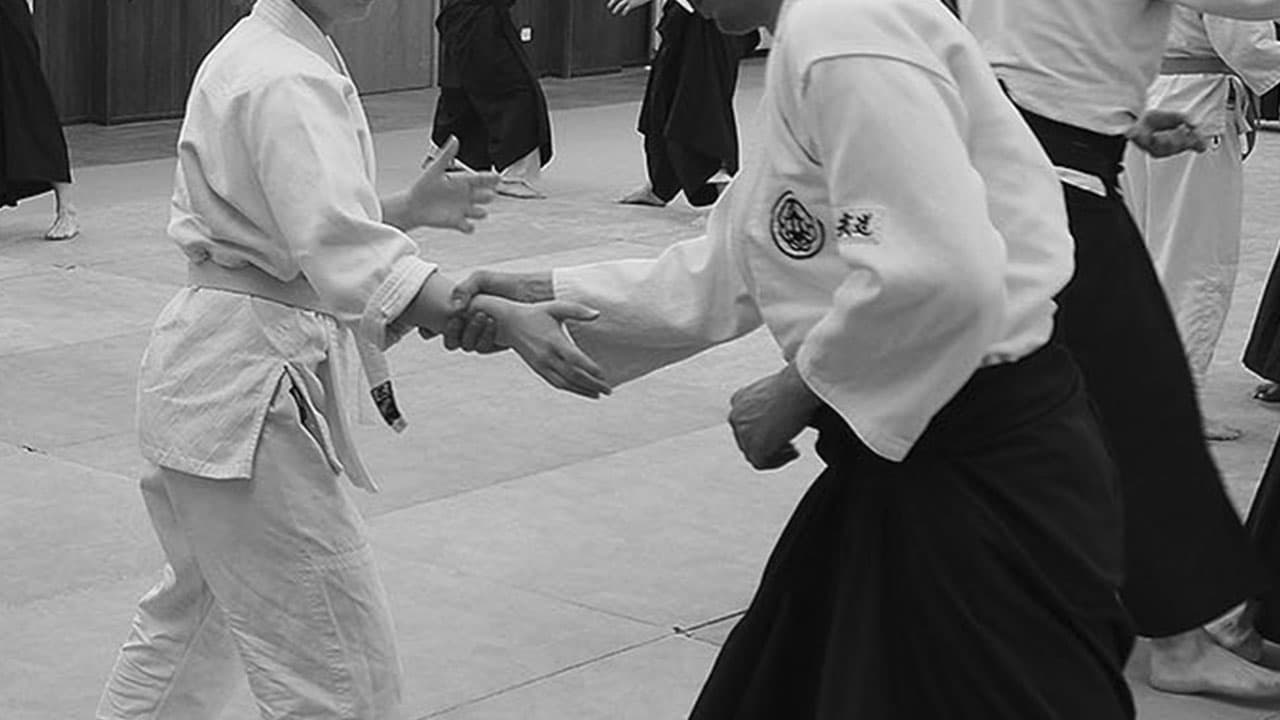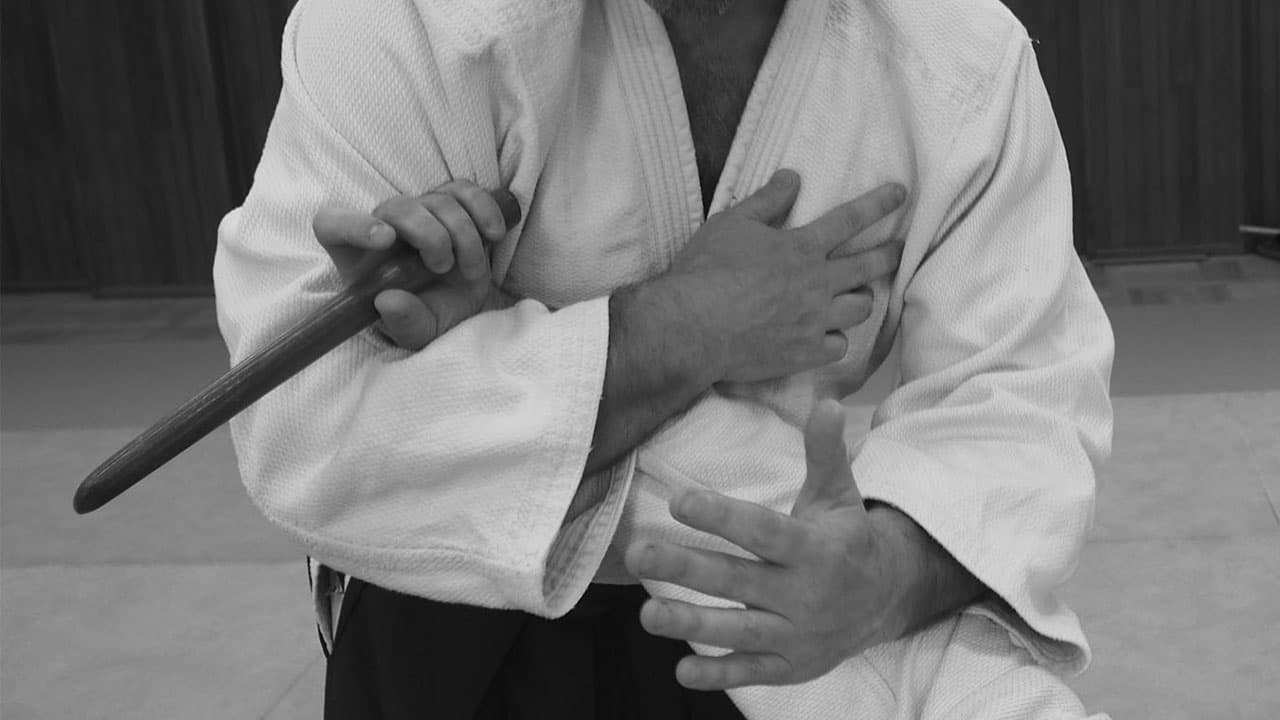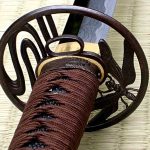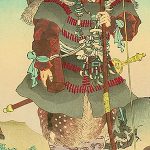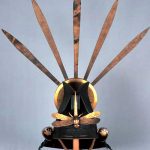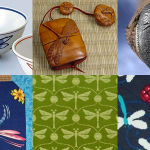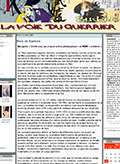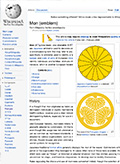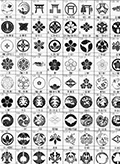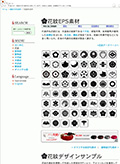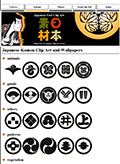•••♦ Le Kamon du club ♦•••
L’origine du logo de notre club vient de la tradition japonaise qui consistait à porter un insigne facilement reconnaissable sur le champ de bataille. On le désigne par les noms kamon ou mondokoro qui représente les armoiries des clans de famille et le mot mon qui désigne un insigne en général et qui est porté plutôt par un individu.

Les thématiques qui sont utilisés pour les kamon sont très nombreuses mais s’inspirent principalement de leur environnement naturel. On retrouve des éléments de la faune et de la flore, des objets du quotidien, des éléments d’architecture, des symboles, des lettre ou encore des kanji.
 La difficulté était de choisir un symbole qui puisse représenter au mieux notre club mais aussi notre pratique d’un art martial. C’est un collègue de travail, un amoureux du Japon, qui posa la question directement à un japonais qui nous indiqua alors la libellule comme animal porte-bonheur, symbole de courage, de force et de joie. Cela correspondait tout à fait à l’image de notre discipline.
La difficulté était de choisir un symbole qui puisse représenter au mieux notre club mais aussi notre pratique d’un art martial. C’est un collègue de travail, un amoureux du Japon, qui posa la question directement à un japonais qui nous indiqua alors la libellule comme animal porte-bonheur, symbole de courage, de force et de joie. Cela correspondait tout à fait à l’image de notre discipline.
Le nom japonais pour la libellule a plusieurs écritures possibles et varie de tonbo à tombo, tombow ou encore akitsu. L’appellation la plus courante étant tonbo. (kanji de tonbo)
Le texte ci-dessous est un résumé des origines et de l’attachement des japonais à la libellule. Ces informations ont été trouvées sur internet. Vous pouvez lire leur contenu intégral au bas de cette page.
L’attachement du japonais envers des insectes comme les mantes religieuses, les araignées ou encore les libellules est très ancien. En effet ces insectes sont bénéfiques pour l’homme, car ils se nourrissent de prédateurs qui pouvaient manger les récoltes.
L’histoire mythologique du Japon ancien rapporte également que le premier empereur, Jimmu Tenno, a déclaré en contemplant du haut d’une montagne ses terres, que son pays avait la forme de deux akitsu accouplés. Ces mêmes annales relatent le prodigieux incident survenu à ce même empereur. Alors qu’il était en train de chasser, un taon vint se poser sur son bras, prêt à le piquer. Une libellule passant par là se jeta sur l’insecte et l’emporta avec elle. Cet incident ravit notre empereur, à tel point qu’il décréta que la région s’appellerait désormais “Akitsu-no”, la “Plaine de la Libellule”. C’est de là aussi que daterait l’appellation de “Akitsu Shima” (Les îles des Libellules) pour désigner le Japon.
La libellule était donc considérée comme un achi-mushi (insecte victorieux) synonyme de bonheur et de chance. Cette affection du Japonais envers cet animal donna lieu à de nombreuses représentations que l’on retrouve sur des casques de samouraïs, sur des tsuba de sabres ainsi que sur de nombreux objets du quotidien, dans des poèmes et des chansons.
Tous ces textes me confortèrent dans le choix de cet animal comme emblème de notre club. Il ne me restait plus qu’a le réaliser. Retour sur le net pour chercher de la documentation sur cet insecte et ses représentations. Après une première série de pistes, le logo final a été soumis au vote auprès des membres du club qui ont pu choisir parmi les variantes proposées pour finalement adopté celui qui se trouve sur ce site.
Sites internet en référence au mon/kamon
Liens complémentaires et références
Le Japonais passe pour le plus fervent amoureux d’insectes au monde. Et ses préférés sont précisément les libellules, les lucioles éclairant les nuits d’été et les grillons sonorisant puissamment les belles nuits d’automne.
À l’état larvaire, la libellule se développe dans les pièces d’eau, innombrables au Japon, chaque rizière, rivière ou ruisseau en constituant une où se développer. On ne dénombre pas moins de 190 variétés de libellules au Japon, et leur population est elle-même impressionnante. L’histoire nous apprend que depuis les temps les plus anciens, les Japonais n’ont jamais rien aimé tant qu’observer ces très gracieux archiptères.
Les preuves les plus anciennes de cet attachement sont des représentations figurant sur des dotaku, ces cloches cérémonielles en bronze fondues entre le milieu et la fin de la période Yayoi (env. IIe siècle av.J.-C. au IIIe siècle ap. J.-C.). Certaines de ces dotaku, qui pouvaient se suspendre, étaient décorées de motifs assez primitifs de libellules, mantes religieuses et araignées. Autant d’insectes et arachnides bénéfiques pour l’homme puisqu’ils faisaient bombance d’insectes prédateurs des précieux plantes de riz. Les historiens voient dans ces représentations des prières pour une bonne récolte.
Histoire mythologique du Japon ancien, le Nihon Shoki (Annales du Japon, rédigées en 720) mentionne la libellule, alors appelée akitsu. Les Annales rapportent également que le premier empereur Jimmu Tenno ayant gravi une petite montagne du Yamato (aujourd’hui Préfecture de Nara) laissa errer son regard sur ces terres qu’il gouvernait, pour déclarer : “Mon pays a la forme de deux akitsu accouplés.”
Les Annales décrivent également un incident prodigieux survenu à l’Empereur Yuryaku Tenno, vingt et unième de la lignée, alors qu’il chassait sur la lande de Yoshino (Sud de l’actuelle Préfecture de Nara). Un taon s’était posé sur l’auguste bras qu’il s’apprêtait à piquer cruellement. Une libellule qui volait par là, alarmée, fondit à ailes racourcies sur l’impertinent et l’emporta dans les airs. Ce service emplit d’aise l’Empereur, à telle enseigne qu’il décréta que la région s’appellerait désormais “Akitsu-no”, la “Plaine de la Libellule”. Et les Annales d’ajouter que de cet incident date l’appellation de “Akitsu Shima” (Les Îles des Libellules) qui est une ancienne désignation du Japon.
La libellule était donc considérée comme un kachi-mushi (insecte victorieux) porteur de chance et de bonheur, peut-être depuis cet épisode du combat avec le taon. Et c’est depuis ce temps que l’on vit des heaumes de preux samouraïs ou des casques de piétaille, armoiries familiales et autres objets encore, s’orner du dessin ou du motif schématisé de la libellule victorieuse et d’heureux augure.
Dans un recueil remontant à la fin du XIIe siècle nous retrouvons une chanson expliquant comment capturer les libellules, car les enfants japonais se livrent joyeusement à cette chasse depuis des siècles. Ils les observent attentivement, découvrent leurs mœurs et inventent des procédés pour les capturer. Un de ceux-ci est détaillé dans la première encyclopédie illustrée du Japon, publiée au début du XVIIIe siècle par Terajima Ryoan sous le titre Wakan Sansai Zue (Collection Illustrée sino-japonaise des trois Éléments de l’Univers). L’illustration nous montre Dame Libellule attachée par un fil à un court bâton pour servir d’appât à Monsieur Libellule. Jusqu’à tout récemment cette méthode dite otori-dori, était extrêmement populaire chez les gosses, qui utilisaient une gin-yamma argentée, ou quelque autre variété de libellule de grande taille.
Autre stratagème de capture : le hikkake-dori. On emballe deux petits cailloux dans deux menues pièces de tissu que l’on attache ensuite aux deux extrémités d’un fil de 60cm de long. On lance ce dispositif en direction d’une gin-yamma argentée qui croit voir se précipiter sur elle une proie facile à dévorer. Las, les ailes (elles en possèdent quatre bien grandes comme un petit hélicoptère) bientôt emberlificotées dans le fil, elle tombera à terre et deviendra elle-même proie facile pour les gosses.
La gin-yamma et autres grandes libellules ne se rencontrant plus trop fréquemment ces dernières années, principalement en raison de la dégradation de son habitat naturel, l’on ne voit plus guère ces joyeuses bandes d’enfants la pourchassant. Il reste à souhaiter que les techniques traditionnelles de capture de la libellule, imaginées par l’observation des mœurs de cet archiptère, continueront à vivre et se transmettre aux générations futures.
Mais nous continueront vraisemblablement à entonner Aka-tombo (Libellule Rouge), cette adorable chanson d’enfants, écrite en 1921. D’ailleurs, dans le cadre des activités de sauvegarde de l’environnement, nombreux sont les groupes qui ont mis à la mode l’aménagement de petites pièces d’eau pour y attirer les libellules. Nous souhaitons donc de tout cœur que cette “culture de la libellule ”, unique au Japon, continuera de vivre dans les siècles à venir.
lien de la citation
http://web-japan.org/nipponia/nipponia29/fr/animal/animal01.html
A dragonfly, or “tombo”, is a creature that is deeply rooted in Japanese symbolism. Very few insects are represented in Japanese folk tales; the dragonfly is an exception. In traditional folk tales it is a creature that is associated with the bringing of wealth.(Yanigata, 1948) In samurai culture the dragonfly has a unique word that is used only in samurai context; kachi mushi. Kachimushi literally means, “the bug that wins” or more commonly “Victory insect”. It is revered historically as an insect that only flies forward and does not retreat, and because of this has a redeeming quality that is respected. Symbols of dragonflies are often incorporated into the handles of swords or fashioned as three dimensional crests and affixed to the front of a samurai’s helmet in battle.(Sasama 1999) Dragonflies are used in several different “kamon” or family crest designs which are used to designate lineage.(Kaneda and Hawley 1994) Crests are perhaps one of the most historically important symbols in Japanese culture. Where honor and family ties are interrelated the crest of a family does much more than represent the line, it emulates ideals that are important to the family or qualities that the members of the family wish to live up to.(Dower 2000) The famous general Honda Tadakatsu, was known to own a spear that cut a dragonfly straight through the middle. Because of this it was thought to have magical powers and possess “mana” or spiritual energy. Thus it was named “Tombogiri” (dragonfly cutter). (Sato 1983)
In Japan dragonflies are symbols of courage, strength, and happiness, and they often appear in art and literature, especially haiku. In ancient mythology, Japan was known as Akitsushima, which means “Land of the Dragonflies”. The love for dragonflies is reflected by the fact that there are traditional names for almost all of the 200 species of dragonflies found in and around Japan.[7] Japanese children catch large dragonflies as a game, using a hair with a small pebble tied to each end, which they throw into the air. The dragonfly mistakes the pebbles for prey, gets tangled in the hair, and is dragged to the ground by the weight.[8]
Also, in Japan, amongst the Three Great Spears of Japan is one which is called the Tonbo-giri, which when translated is called ‘The Dragon Fly Cutter’. The spear is an important part of Japans imperial regalia- the spear itself was once wielded by the legendary Samurai, Honda Tadakatsu. It’s name is derived from the story that the blade is so sharp, a dragon fly once landed on it and was instantly cut in half.
Lien de la citation
http://en.wikipedia.org/wiki/Dragonfly
Dragonfly symbolism crosses and combines with that of the butterfly and change. The dragonfly symbolizes going past self-created illusions that limit our growing and changing. Dragonflies are a symbol of the sense of self that comes with maturity.
They are fantastic flyers, darting like light, twisting, turning, changing direction, even going backwards as the need arises. They are inhabitants of two realms – starting with water, and moving to the air with maturity, but staying close to water. Some people who have the dragonfly as their totem have had emotional and passionate early years, but as they get older they achieve balance with mental clarity and control. They gain an expression of the emotional and mental together.
Dragonflies are old and adaptive insects, and are most powerful in the summer under the effects of warmth and sunlight. Their colors are a result of reflecting and refracting the power of light. As a result, they are associated with color magic, illusion in causing others only to see what you wish, and other mysticism.
The are often represented in Japanese paintings, representing new light and joy. To some Native Americans they are the souls of the dead. Faerie stories say that they used to be real dragons.
Dragonflies are reminders that we are light and can reflect the light in powerful ways if we choose to do so. “Let there be light” is the divine prompting to use the creative imagination as a force within your life. They help you to see through your illusions and allow your own light to shine in a new vision.
Lien de la citation
http://wiki.answers.com/Q/Meaning_of_dragonfly_symbol
Here are opinions and answers from WikiAnswers Contributors:
> I have one and it’s for good luck.
> The artist who did my dragonfly tattoo told me that it symbolizes freedom.
> The dragon fly is symbolic for change and being okay with it. Here is a story: The Dragonfly Once, in a little pond, in the muddy water under the lily pads, there lived a little water beetle in a community of water beetles. They lived a simple and comfortable life in the pond with few disturbances and interruptions. Once in a while, sadness would come to the community when one of their fellow beetles would climb the stem of a lily pad and would never be seen again. They knew when this happened; their friend was dead, gone forever. Then, one day, one little water beetle felt an irresistible urge to climb up that stem. However, he was determined that he would not leave forever. He would come back and tell his friends what he had found at the top. When he reached the top and climbed out of the water onto the surface of the lily pad, he was so tired, and the sun felt so warm, that he decided he must take a nap. As he slept, his body changed and when he woke up, he had turned into a beautiful blue tailed dragonfly with broad wings and a slender body designed for flying. So, fly he did! And, as he soared he saw the beauty of a whole new world and a far superior way of life to what he had never known existed. Then he remembered his beetle friends and how they were thinking by now he was dead. He wanted to go back to tell them, and explain to them that he was now more alive than he had ever been before. His life had been fulfilled rather than ended. But, his new body would not go down into the water. He could not get back to tell his friends the good news. Then he understood that their time would come, when they, too, would know what he now knew. So, he raised his wings and flew off into his joyous new life!
> The dragonfly’s shell is designed with special facets that reflect and refract their beautiful colors in the light of the sun. This almost sparkling appearance has leant added meaning to the dragonfly’s form. They’ve taken on a mystical and magical symbolism. The dragonfly’s magic is its light magic, and all of the wonderful similes, metaphors and clich’s that light has inspired. In Japan, the Japanese people have chosen to honor the dragonfly as a symbol of joy and new light. Thus, the dragonfly has come to be an image that inspires us to not only learn to practice the shedding and mirroring of light in our own lives, but to learn to see when others are doing it, too! Additionally, dragonflies certainly aren’t limited to women! In Native American astrology, there is a strong belief that each person has a totem animal spirit which serves as their guardians and guides through certain phases of life. Often, an individual would have many different totems throughout life, some for just a time, and some for their entire lives. And one of these totem spirits was the spirit of the dragonfly. It would adopt men and women, young and old. The dragonfly spirit means you must consciously make an effort to express your hopes, dreams, needs and wishes. The dragonfly spirit is the essence of the winds of change, the messages of wisdom and enlightenment; and the communication from the elemental world. Its medicine beckons you to seek out the parts of your habits which need changing. You can turn to the dragonfly to guide you through the mists of illusion to the pathway of transformation.
> Three bugs talking about the mysteries of life. Once in a while one friend would crawl up a piece of grass and disappear forever. They made a pact that if one of them left they would come back and let the others know what happened. One day it happened, he had the call to climb the grass and as he broke through the surface he paused and shook away his hard shell and discovered he had wings. He found he could fly and in his flight he discovered his world was brighter than anything he had ever imagined and the beauty was breathtaking. He remembered his pact with the others below and started down to the water. He tried and tried to break through the surface to reach his friends and couldn’t. He know they would join him one day and that they too would see the beauty of this new world. The birth of the dragonfly after his years of life as a larva. This story was used to explain the death and passage to heaven of a grandparent to a child. I lost my mother and this story also brought me comfort. I also wait to break out of the murky water and join the others I love in the bright light of Heaven.
> I have a Dragonfly/Katsumushi tattoo’d on my right leg. It was a gift to me on my 30th birthday from someone who had taught me much.. It symbolizes invincibility, wisdom, speed/agility, and is symbolic of being a messenger from ~ another world. It is still considered by some of us as good luck in returning from battle.
> The dragonfly represents many things to different cultures. I will add that in ancient Japanese culture, the dragonfly represented protection and good luck to warriors on the battle field. In many Native American tribes dragonflies symbolize whirlwind, swiftness and much activity. That being said, having a dragonfly tattoo could be a representation of any of these symbols.
Lien de la citation
http://wiki.answers.com/Q/What_does_a_dragonfly_tattoo_symbolize
History
Living fossils, dragonflies are part of the most ancient group of insects on this planet. They were soaring through the air and lived on earth for a staggering three hundred million years. Compared to humans, they are very old indeed. We have only been around fro about 2 million years. Insects were the first creatures in the world to fly. Dragonflies were flying in steamy prehistoric forest long before the dinosaurs appeared. We know about these ancient dragonflies through fossils. Back then, dragonflies were much larger and had wingspans of 80 cm (31.5 inches) and were the largest insects known. Today, dragonflies are smaller, with wingspans up to 14 cm (5.5 in).
Over the centuries, people thought about dragonflies in many ways. In ancient times, Japanese farmers believed the dragonfly was the spirit of the rice plant. Dragonflies were a welcome sign of a good rice harvest. Dragonflies were also believed to bring good luck in battle. About 1600 years ago, the dragonfly was the symbol of a great Japanese warrior clan. The dragonfly later became one of the emblems of the emperor. An old name for Japan – Akitsu-shimu – means Dragonfly Island. The dragonfly is praised in many Japanese poems and songs.
The Mimbres people of the American southwest painted the dragonfly on ceremonial pottery as a symbol of life.
The Zuni tell an ancient story of a magic dragonfly made from corn and straw. It came to life in a time of drought and famine, became a messenger to the gods, and helped save the people. But not everyone has liked dragonflies.
In Great Britain, they were once considered evil and dangerous. Because people saw them darting at horses, the dragonflies were called “horse-stingers.” They didn’t realize the dragonflies were snatching horseflies, the real “horse-stingers.”
Lien de la citation
http://wiki.answers.com/Q/What_is_the_symbolism_of_the_dragonfly_in_Japan
Le Kamon du club
L’origine du logo de notre club vient de la tradition japonaise qui consistait à porter un insigne facilement reconnaissable sur le champ de bataille. On le désigne par les noms kamon ou mondokoro qui représente les armoiries des clans de famille et le mot mon qui désigne un insigne en général et qui est porté plutôt par un individu.

Les thématiques qui sont utilisés pour les kamon sont très nombreuses mais s’inspirent principalement de leur environnement naturel. On retrouve des éléments de la faune et de la flore, des objets du quotidien, des éléments d’architecture, des symboles, des lettre ou encore des kanji.
 La difficulté était de choisir un symbole qui puisse représenter au mieux notre club mais aussi notre pratique d’un art martial. C’est un collègue de travail, un amoureux du Japon, qui posa la question directement à un japonais qui nous indiqua alors la libellule comme animal porte-bonheur, symbole de courage, de force et de joie. Cela correspondait tout à fait à l’image de notre discipline.
La difficulté était de choisir un symbole qui puisse représenter au mieux notre club mais aussi notre pratique d’un art martial. C’est un collègue de travail, un amoureux du Japon, qui posa la question directement à un japonais qui nous indiqua alors la libellule comme animal porte-bonheur, symbole de courage, de force et de joie. Cela correspondait tout à fait à l’image de notre discipline.
Le nom japonais pour la libellule a plusieurs écritures possibles et varie de tonbo à tombo, tombow ou encore akitsu. L’appellation la plus courante étant tonbo. (kanji de tonbo)
Le texte ci-dessous est un résumé des origines et de l’attachement des japonais à la libellule. Ces informations ont été trouvées sur internet. Vous pouvez lire leur contenu intégral au bas de cette page.
L’attachement du japonais envers des insectes comme les mantes religieuses, les araignées ou encore les libellules est très ancien. En effet ces insectes sont bénéfiques pour l’homme, car ils se nourrissent de prédateurs qui pouvaient manger les récoltes.
L’histoire mythologique du Japon ancien rapporte également que le premier empereur, Jimmu Tenno, a déclaré en contemplant du haut d’une montagne ses terres, que son pays avait la forme de deux akitsu accouplés. Ces mêmes annales relatent le prodigieux incident survenu à ce même empereur. Alors qu’il était en train de chasser, un taon vint se poser sur son bras, prêt à le piquer. Une libellule passant par là se jeta sur l’insecte et l’emporta avec elle. Cet incident ravit notre empereur, à tel point qu’il décréta que la région s’appellerait désormais “Akitsu-no”, la “Plaine de la Libellule”. C’est de là aussi que daterait l’appellation de “Akitsu Shima” (Les îles des Libellules) pour désigner le Japon.
La libellule était donc considérée comme un achi-mushi (insecte victorieux) synonyme de bonheur et de chance. Cette affection du Japonais envers cet animal donna lieu à de nombreuses représentations que l’on retrouve sur des casques de samouraïs, sur des tsuba de sabres ainsi que sur de nombreux objets du quotidien, dans des poèmes et des chansons.
Tous ces textes me confortèrent dans le choix de cet animal comme emblème de notre club. Il ne me restait plus qu’a le réaliser. Retour sur le net pour chercher de la documentation sur cet insecte et ses représentations. Après une première série de pistes, le logo final a été soumis au vote auprès des membres du club qui ont pu choisir parmi les variantes proposées pour finalement adopté celui qui se trouve sur ce site.
Sites internet en référence au mon/kamon
Bonne explication en français sur l’origine des kamon. Ce texte est en partie la traduction du wikipédia anglais.
Sur le site de wikipedia on trouve une explication complète sur les mon et kamon mais c’est en anglais. La version française est pour l’instant qu’une ébauche
Encore un site en japonais avec une énorme quantité de kamon. Pour accéder aux différentes pages il faut revenir à cette page et choisir une catégorie de la colonne de gauche.
Très belle collection de kamon téléchargeables au format eps, éditables dans un programme comme illustrator.
Très belle collection de kamon téléchargeables au format eps, éditables dans un programme comme illustrator.
Liens complémentaires et références
Le Japonais passe pour le plus fervent amoureux d’insectes au monde. Et ses préférés sont précisément les libellules, les lucioles éclairant les nuits d’été et les grillons sonorisant puissamment les belles nuits d’automne.
À l’état larvaire, la libellule se développe dans les pièces d’eau, innombrables au Japon, chaque rizière, rivière ou ruisseau en constituant une où se développer. On ne dénombre pas moins de 190 variétés de libellules au Japon, et leur population est elle-même impressionnante. L’histoire nous apprend que depuis les temps les plus anciens, les Japonais n’ont jamais rien aimé tant qu’observer ces très gracieux archiptères.
Les preuves les plus anciennes de cet attachement sont des représentations figurant sur des dotaku, ces cloches cérémonielles en bronze fondues entre le milieu et la fin de la période Yayoi (env. IIe siècle av.J.-C. au IIIe siècle ap. J.-C.). Certaines de ces dotaku, qui pouvaient se suspendre, étaient décorées de motifs assez primitifs de libellules, mantes religieuses et araignées. Autant d’insectes et arachnides bénéfiques pour l’homme puisqu’ils faisaient bombance d’insectes prédateurs des précieux plantes de riz. Les historiens voient dans ces représentations des prières pour une bonne récolte.
Histoire mythologique du Japon ancien, le Nihon Shoki (Annales du Japon, rédigées en 720) mentionne la libellule, alors appelée akitsu. Les Annales rapportent également que le premier empereur Jimmu Tenno ayant gravi une petite montagne du Yamato (aujourd’hui Préfecture de Nara) laissa errer son regard sur ces terres qu’il gouvernait, pour déclarer : “Mon pays a la forme de deux akitsu accouplés.”
Les Annales décrivent également un incident prodigieux survenu à l’Empereur Yuryaku Tenno, vingt et unième de la lignée, alors qu’il chassait sur la lande de Yoshino (Sud de l’actuelle Préfecture de Nara). Un taon s’était posé sur l’auguste bras qu’il s’apprêtait à piquer cruellement. Une libellule qui volait par là, alarmée, fondit à ailes racourcies sur l’impertinent et l’emporta dans les airs. Ce service emplit d’aise l’Empereur, à telle enseigne qu’il décréta que la région s’appellerait désormais “Akitsu-no”, la “Plaine de la Libellule”. Et les Annales d’ajouter que de cet incident date l’appellation de “Akitsu Shima” (Les Îles des Libellules) qui est une ancienne désignation du Japon.
La libellule était donc considérée comme un kachi-mushi (insecte victorieux) porteur de chance et de bonheur, peut-être depuis cet épisode du combat avec le taon. Et c’est depuis ce temps que l’on vit des heaumes de preux samouraïs ou des casques de piétaille, armoiries familiales et autres objets encore, s’orner du dessin ou du motif schématisé de la libellule victorieuse et d’heureux augure.
Dans un recueil remontant à la fin du XIIe siècle nous retrouvons une chanson expliquant comment capturer les libellules, car les enfants japonais se livrent joyeusement à cette chasse depuis des siècles. Ils les observent attentivement, découvrent leurs mœurs et inventent des procédés pour les capturer. Un de ceux-ci est détaillé dans la première encyclopédie illustrée du Japon, publiée au début du XVIIIe siècle par Terajima Ryoan sous le titre Wakan Sansai Zue (Collection Illustrée sino-japonaise des trois Éléments de l’Univers). L’illustration nous montre Dame Libellule attachée par un fil à un court bâton pour servir d’appât à Monsieur Libellule. Jusqu’à tout récemment cette méthode dite otori-dori, était extrêmement populaire chez les gosses, qui utilisaient une gin-yamma argentée, ou quelque autre variété de libellule de grande taille.
Autre stratagème de capture : le hikkake-dori. On emballe deux petits cailloux dans deux menues pièces de tissu que l’on attache ensuite aux deux extrémités d’un fil de 60cm de long. On lance ce dispositif en direction d’une gin-yamma argentée qui croit voir se précipiter sur elle une proie facile à dévorer. Las, les ailes (elles en possèdent quatre bien grandes comme un petit hélicoptère) bientôt emberlificotées dans le fil, elle tombera à terre et deviendra elle-même proie facile pour les gosses.
La gin-yamma et autres grandes libellules ne se rencontrant plus trop fréquemment ces dernières années, principalement en raison de la dégradation de son habitat naturel, l’on ne voit plus guère ces joyeuses bandes d’enfants la pourchassant. Il reste à souhaiter que les techniques traditionnelles de capture de la libellule, imaginées par l’observation des mœurs de cet archiptère, continueront à vivre et se transmettre aux générations futures.
Mais nous continueront vraisemblablement à entonner Aka-tombo (Libellule Rouge), cette adorable chanson d’enfants, écrite en 1921. D’ailleurs, dans le cadre des activités de sauvegarde de l’environnement, nombreux sont les groupes qui ont mis à la mode l’aménagement de petites pièces d’eau pour y attirer les libellules. Nous souhaitons donc de tout cœur que cette “culture de la libellule ”, unique au Japon, continuera de vivre dans les siècles à venir.
lien de la citation
http://web-japan.org/nipponia/nipponia29/fr/animal/animal01.html
A dragonfly, or “tombo”, is a creature that is deeply rooted in Japanese symbolism. Very few insects are represented in Japanese folk tales; the dragonfly is an exception. In traditional folk tales it is a creature that is associated with the bringing of wealth.(Yanigata, 1948) In samurai culture the dragonfly has a unique word that is used only in samurai context; kachi mushi. Kachimushi literally means, “the bug that wins” or more commonly “Victory insect”. It is revered historically as an insect that only flies forward and does not retreat, and because of this has a redeeming quality that is respected. Symbols of dragonflies are often incorporated into the handles of swords or fashioned as three dimensional crests and affixed to the front of a samurai’s helmet in battle.(Sasama 1999) Dragonflies are used in several different “kamon” or family crest designs which are used to designate lineage.(Kaneda and Hawley 1994) Crests are perhaps one of the most historically important symbols in Japanese culture. Where honor and family ties are interrelated the crest of a family does much more than represent the line, it emulates ideals that are important to the family or qualities that the members of the family wish to live up to.(Dower 2000) The famous general Honda Tadakatsu, was known to own a spear that cut a dragonfly straight through the middle. Because of this it was thought to have magical powers and possess “mana” or spiritual energy. Thus it was named “Tombogiri” (dragonfly cutter). (Sato 1983)
In Japan dragonflies are symbols of courage, strength, and happiness, and they often appear in art and literature, especially haiku. In ancient mythology, Japan was known as Akitsushima, which means “Land of the Dragonflies”. The love for dragonflies is reflected by the fact that there are traditional names for almost all of the 200 species of dragonflies found in and around Japan.[7] Japanese children catch large dragonflies as a game, using a hair with a small pebble tied to each end, which they throw into the air. The dragonfly mistakes the pebbles for prey, gets tangled in the hair, and is dragged to the ground by the weight.[8]
Also, in Japan, amongst the Three Great Spears of Japan is one which is called the Tonbo-giri, which when translated is called ‘The Dragon Fly Cutter’. The spear is an important part of Japans imperial regalia- the spear itself was once wielded by the legendary Samurai, Honda Tadakatsu. It’s name is derived from the story that the blade is so sharp, a dragon fly once landed on it and was instantly cut in half.
Lien de la citation
http://en.wikipedia.org/wiki/Dragonfly
Dragonfly symbolism crosses and combines with that of the butterfly and change. The dragonfly symbolizes going past self-created illusions that limit our growing and changing. Dragonflies are a symbol of the sense of self that comes with maturity.
They are fantastic flyers, darting like light, twisting, turning, changing direction, even going backwards as the need arises. They are inhabitants of two realms – starting with water, and moving to the air with maturity, but staying close to water. Some people who have the dragonfly as their totem have had emotional and passionate early years, but as they get older they achieve balance with mental clarity and control. They gain an expression of the emotional and mental together.
Dragonflies are old and adaptive insects, and are most powerful in the summer under the effects of warmth and sunlight. Their colors are a result of reflecting and refracting the power of light. As a result, they are associated with color magic, illusion in causing others only to see what you wish, and other mysticism.
The are often represented in Japanese paintings, representing new light and joy. To some Native Americans they are the souls of the dead. Faerie stories say that they used to be real dragons.
Dragonflies are reminders that we are light and can reflect the light in powerful ways if we choose to do so. “Let there be light” is the divine prompting to use the creative imagination as a force within your life. They help you to see through your illusions and allow your own light to shine in a new vision.
Lien de la citation
http://wiki.answers.com/Q/Meaning_of_dragonfly_symbol
Here are opinions and answers from WikiAnswers Contributors:
> I have one and it’s for good luck.
> The artist who did my dragonfly tattoo told me that it symbolizes freedom.
> The dragon fly is symbolic for change and being okay with it. Here is a story: The Dragonfly Once, in a little pond, in the muddy water under the lily pads, there lived a little water beetle in a community of water beetles. They lived a simple and comfortable life in the pond with few disturbances and interruptions. Once in a while, sadness would come to the community when one of their fellow beetles would climb the stem of a lily pad and would never be seen again. They knew when this happened; their friend was dead, gone forever. Then, one day, one little water beetle felt an irresistible urge to climb up that stem. However, he was determined that he would not leave forever. He would come back and tell his friends what he had found at the top. When he reached the top and climbed out of the water onto the surface of the lily pad, he was so tired, and the sun felt so warm, that he decided he must take a nap. As he slept, his body changed and when he woke up, he had turned into a beautiful blue tailed dragonfly with broad wings and a slender body designed for flying. So, fly he did! And, as he soared he saw the beauty of a whole new world and a far superior way of life to what he had never known existed. Then he remembered his beetle friends and how they were thinking by now he was dead. He wanted to go back to tell them, and explain to them that he was now more alive than he had ever been before. His life had been fulfilled rather than ended. But, his new body would not go down into the water. He could not get back to tell his friends the good news. Then he understood that their time would come, when they, too, would know what he now knew. So, he raised his wings and flew off into his joyous new life!
> The dragonfly’s shell is designed with special facets that reflect and refract their beautiful colors in the light of the sun. This almost sparkling appearance has leant added meaning to the dragonfly’s form. They’ve taken on a mystical and magical symbolism. The dragonfly’s magic is its light magic, and all of the wonderful similes, metaphors and clich’s that light has inspired. In Japan, the Japanese people have chosen to honor the dragonfly as a symbol of joy and new light. Thus, the dragonfly has come to be an image that inspires us to not only learn to practice the shedding and mirroring of light in our own lives, but to learn to see when others are doing it, too! Additionally, dragonflies certainly aren’t limited to women! In Native American astrology, there is a strong belief that each person has a totem animal spirit which serves as their guardians and guides through certain phases of life. Often, an individual would have many different totems throughout life, some for just a time, and some for their entire lives. And one of these totem spirits was the spirit of the dragonfly. It would adopt men and women, young and old. The dragonfly spirit means you must consciously make an effort to express your hopes, dreams, needs and wishes. The dragonfly spirit is the essence of the winds of change, the messages of wisdom and enlightenment; and the communication from the elemental world. Its medicine beckons you to seek out the parts of your habits which need changing. You can turn to the dragonfly to guide you through the mists of illusion to the pathway of transformation.
> Three bugs talking about the mysteries of life. Once in a while one friend would crawl up a piece of grass and disappear forever. They made a pact that if one of them left they would come back and let the others know what happened. One day it happened, he had the call to climb the grass and as he broke through the surface he paused and shook away his hard shell and discovered he had wings. He found he could fly and in his flight he discovered his world was brighter than anything he had ever imagined and the beauty was breathtaking. He remembered his pact with the others below and started down to the water. He tried and tried to break through the surface to reach his friends and couldn’t. He know they would join him one day and that they too would see the beauty of this new world. The birth of the dragonfly after his years of life as a larva. This story was used to explain the death and passage to heaven of a grandparent to a child. I lost my mother and this story also brought me comfort. I also wait to break out of the murky water and join the others I love in the bright light of Heaven.
> I have a Dragonfly/Katsumushi tattoo’d on my right leg. It was a gift to me on my 30th birthday from someone who had taught me much.. It symbolizes invincibility, wisdom, speed/agility, and is symbolic of being a messenger from ~ another world. It is still considered by some of us as good luck in returning from battle.
> The dragonfly represents many things to different cultures. I will add that in ancient Japanese culture, the dragonfly represented protection and good luck to warriors on the battle field. In many Native American tribes dragonflies symbolize whirlwind, swiftness and much activity. That being said, having a dragonfly tattoo could be a representation of any of these symbols.
Lien de la citation
http://wiki.answers.com/Q/What_does_a_dragonfly_tattoo_symbolize
History
Living fossils, dragonflies are part of the most ancient group of insects on this planet. They were soaring through the air and lived on earth for a staggering three hundred million years. Compared to humans, they are very old indeed. We have only been around fro about 2 million years. Insects were the first creatures in the world to fly. Dragonflies were flying in steamy prehistoric forest long before the dinosaurs appeared. We know about these ancient dragonflies through fossils. Back then, dragonflies were much larger and had wingspans of 80 cm (31.5 inches) and were the largest insects known. Today, dragonflies are smaller, with wingspans up to 14 cm (5.5 in).
Over the centuries, people thought about dragonflies in many ways. In ancient times, Japanese farmers believed the dragonfly was the spirit of the rice plant. Dragonflies were a welcome sign of a good rice harvest. Dragonflies were also believed to bring good luck in battle. About 1600 years ago, the dragonfly was the symbol of a great Japanese warrior clan. The dragonfly later became one of the emblems of the emperor. An old name for Japan – Akitsu-shimu – means Dragonfly Island. The dragonfly is praised in many Japanese poems and songs.
The Mimbres people of the American southwest painted the dragonfly on ceremonial pottery as a symbol of life.
The Zuni tell an ancient story of a magic dragonfly made from corn and straw. It came to life in a time of drought and famine, became a messenger to the gods, and helped save the people. But not everyone has liked dragonflies.
In Great Britain, they were once considered evil and dangerous. Because people saw them darting at horses, the dragonflies were called “horse-stingers.” They didn’t realize the dragonflies were snatching horseflies, the real “horse-stingers.”
Lien de la citation
http://wiki.answers.com/Q/What_is_the_symbolism_of_the_dragonfly_in_Japan
